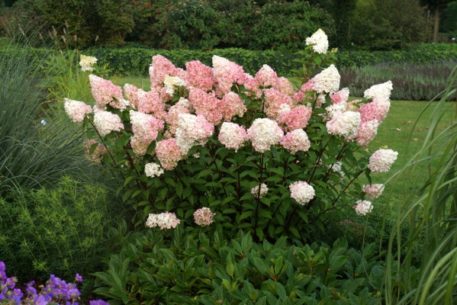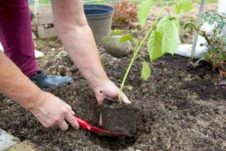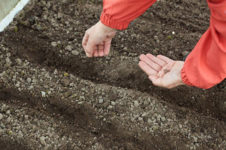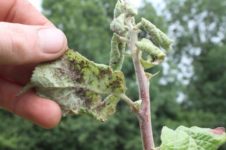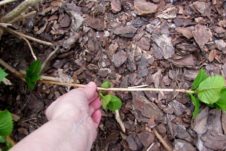Hydrangea Freize Melba is considered relatively new, it appeared for the first time in 2014 at the exhibition Gardens of Russia. Bred a variety in France. This is a surprisingly beautiful flower, non-capricious and unpretentious. It can grow in any region, because it has increased frost resistance, normally tolerates an air temperature of -35 ° C.
Material Content:
Grade description
Hydrangea Freeze Melba has many more benefits. Each plant forms a large number of shoots, the bush grows lush and dense. Each shoot is crowned with a huge inflorescence that blooms snow-white, turns green a little over time, then acquires a pink hue and finishes flowering with red flowers. On one bush you can see inflorescences of different types of ripening.
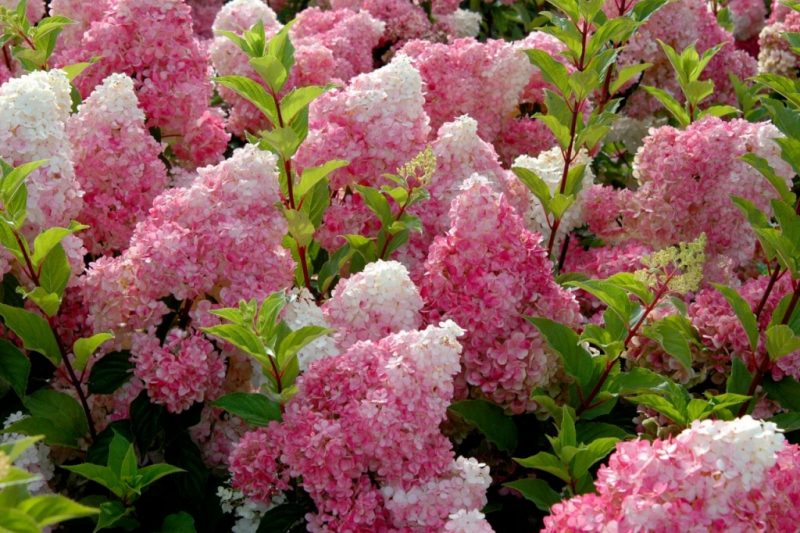
Huge inflorescences, despite their size, do not wilt. The shrub does not need to be tied up and strengthened, its branches have sufficient strength. In any weather, this bush does not lose its shape. The size of its inflorescences is 35–40 cm.
Seed selection and hydrangea planting in open ground
Hydrangea seedlings are usually sold, this method of reproduction allows you to get flowering plants much faster. But you can also plant purchased seeds in open ground or seedlings.
Before sowing in open ground, prepare the site, cleaning it of weeds, leveling with a rake. The main thing is to choose the right place for planting, the plant should receive sunlight for at least 6 hours during the day. If you plant hydrangea in the open sun or in the shade, this will impair the quality of flowering.
You should pay attention to the quality of the soil, it should not contain lime and manure.
Hydrangeas like sour soil, you can add sour peat and pine needles to the plot. The best time for sowing is the end of April, May.
Hydrangea seeds are small, brown, before sowing for better germination, it is advisable to soak them for 8 hours in water. Then scatter on the prepared site without deepening into the soil. Sprinkle on top with a small layer of sand and spray with water. Shoots from frosts must be covered with agrofibre.
Care for hydrangea panicled Frize Melba
Hydrangea Fraise Melba is unpretentious, but at the same time needs constant care. It is necessary to maintain the desired level of soil moisture, remove weeds, feed and trim the bush.
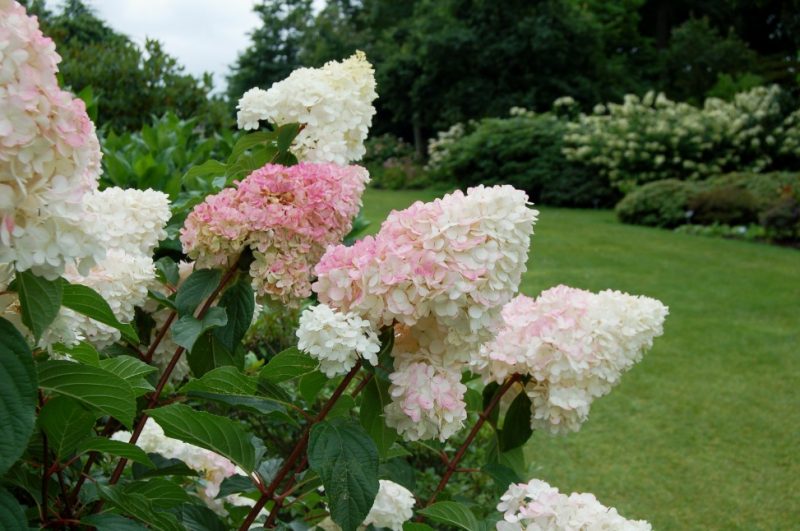
Particular attention should be paid to watering, with a lack of moisture, the plant quickly withers. In dry summers, one adult bush requires about 4 buckets of water daily. If the sandy soil from drying out will save a layer of mulch (peat, hay, needles, bark), it will serve as additional fertilizer. Waterlogging should not be allowed. When it rains, watering is stopped.
For abundant flowering of hydrangea, complex dressing is necessary at least 2 times a year - before and after flowering.
For the first time, nitrogen-containing fertilizer is introduced in April. After flowering, they are fed with complex potassium-phosphorus preparations intended for culture.
Correct forming pruning is carried out in the spring before the start of active vegetation. During it, old and weak shoots are removed, strong and young are left, shortening them by 4 buds. In autumn or spring, dried inflorescences are cut.
Protection against diseases and pests
Variety Friis Melba is resistant to disease. However, errors in care can lead to weakening of the plant. In summer, the bush should receive enough moisture.
In autumn and spring, sanitary pruning is necessary, during which sick and broken branches are removed.
If leaves and trunks turn yellow, oily spots appear - this is a sign of the disease with downy mildew. The diseased plant is treated with a solution of green soap with copper sulfate.
To combat aphids, tobacco infusion or anabazine sulfate helps. From spider mites, they are treated with acaricides or a solution of thiophos.
Preparing the plant for wintering
Panicled hydrangea does not need shelter for the winter. In autumn, it is advisable to cut off wilted inflorescences so that under the weight of the adhering snow they do not break off the shoots.
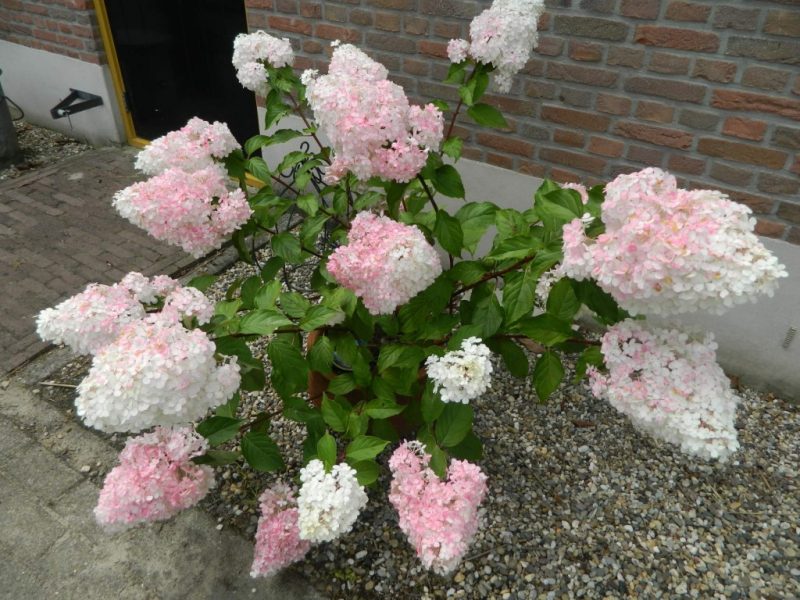
Spend autumn water-charging irrigation. The soil around the bush is highly spudded and mulched, this will protect the root system from freezing. When the thermometer at night drops to 0 ° C, watering is stopped.
Read also:hydrangea tree Annabelle
Methods of propagation of hydrangea Frize Melba
There are several breeding options for this flowering shrub. Each of them requires attention and patience.
The main ways:
- division of the bush;
- offspring;
- cuttings;
- layering from the bush;
- instillation of a seedling.
Cuttings - the most simple and understandable method of reproduction.
It is used in the spring and summer. For harvesting cuttings, a side shoot is cut. If there is an inflorescence on it, it is removed, the shoot is divided into several parts so that each has 2 or 3 internodes.
Then, the lower two leaves are removed on the cuttings, shortening the upper half. The bottom section is treated with a root stimulant, and is rooted in water or substrate, covered with a film. The roots should appear after about 20 days, after which the film is removed.
Application in garden design
Gentle hydrangea is perfect for decorating the garden in a single or group planting. It blends beautifully with coniferous shrubs and evergreen boxwood.
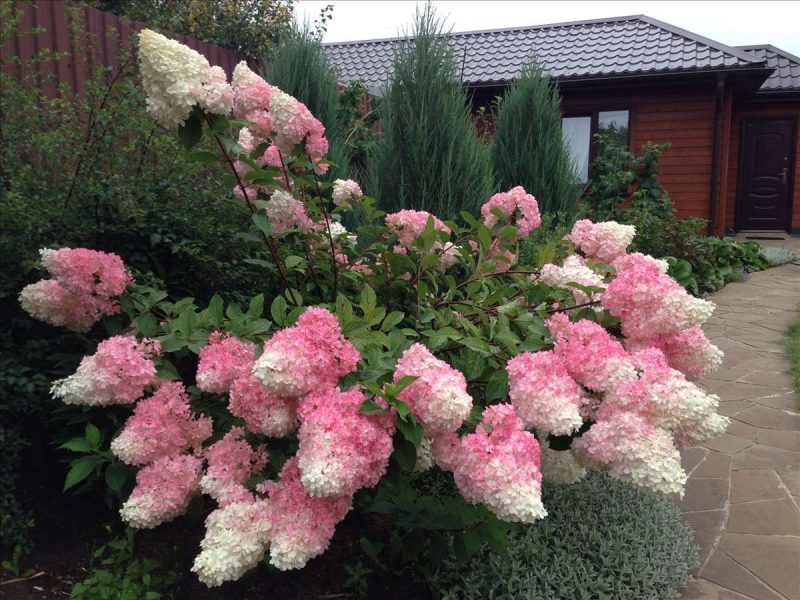
Hydrangea looks interesting next to a lily, a rose, a mock up, lilacs and other flowering perennials that succeed each other during flowering, preventing the garden from becoming boring.
Blooming hydrangea gives the garden a romantic atmosphere,
if you plant it along garden paths. It can become the main decoration of the coastal territory of an artificial reservoir in the garden, along with other moisture-loving flowers.
Panicle hydrangea Freize Melba has been successfully used to design gardens with different styles. It can be placed on the flowerbed, creating patterns, included in the composition of the English flower garden or planted around the perimeter of the site.
It is interesting:hydrangea vanilla frayz


